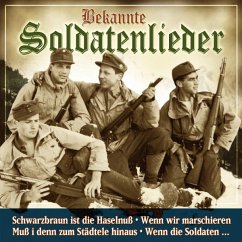


After the small island was traded to Germany in 1890, a monument was erected in 1891 to his memory.
SOLDATENLIEDER. SERIES
The monument was subsequently destroyed in a series of events in and after World War II. * Fünfzig neue Kinderlieder ("Fifty New Children's Songs"), and * Fünfzig Kinderlieder ("Fifty Children's Songs"), * Rheinleben ("Rhine Life", 1865), and in his * Soldatenleben ("Soldier's Life", 1852), * Soldatenlieder ("Soldier Songs", 1851), * Alemannische Lieder ("Alemannic Songs", 1826), The best of his poetical writings is his Gedichte ("Poems", 1827), but there is great merit also in his The rocky island has survived erosion in the North Sea as well as British bombings until 1952, and thus is regarded also as a symbol of resistance.

( xxx)īack at home, there lives a little maiden ( xxx)
SOLDATENLIEDER. FULL
On the heath, there blooms a little flower ( xxx)Įagerly a hundred thousand little bees, ( xxx)įor her heart is full of sweetness, ( xxx)Ī tender scent escapes her blossom-gown. In der Heimat weint um dich ein Mägdelein ( xxx) "Denkst du auch an deine kleine Braut?" ( xxx) Und dann ist es mir, als spräch' es laut: ( xxx) Schon beim Morgengrau'n sowie beim Dämmerschein ( xxx) In mein'm Kämmerlein blüht auch ein Blümelein ( xxx) Wenn das Heidekraut rot-lila blüht,( xxx) In der Heimat wohnt ein kleines Mägdelein ( xxx)ĭieses Mädel ist mein treues Schätzelein ( xxx) ( xxx)Īuf der Heide blüht ein kleines blümelein ( xxx) Heiß von hunderttausend kleinen Bienelein ( xxx)ĭenn ihr Herz ist voller Süßigkeit, ( xxx) of marching soldiers), shown as (xxx) in the text below.Īuf der Heide blüht ein kleines Blümelein ( xxx) After each line, and after each time the name "Erika" is sung, there is a three beat pause, which is filled by the kettledrum or stomping feet (e.g. The song begins with the line "Auf der Heide blüht ein kleines Blümelein" (On the Heath a Little Flower Blooms), the theme of a flower (Erika) bearing a soldier's sweetheart's name. It was extensively played at large political events. The song encourages hard work, and according to Michael Tillotson, no other marching song during World War II reached the popularity of Erika. It had been popular prior to the start of World War II. The song was originally published in 1938 by the publishing firm Louis Oertel in Großburgwedel. The exact year of the song's origin is not known often the date is given as "about 1931", a date that, however, has not been substantiated. The lyrics and melody of the song were written by Herms Niel, a German composer of marches. " Erika" is both a common German female name and the German word for heather.

It was frequently played at large political events, and according to Michael Tillotson, no other marching song during World War II reached the popularity of "Erika". The song was composed by Herms Niel in the 1930s, and it soon came into usage by the Wehrmacht, especially the Heer. " Erika" is a marching song that was used by the German military, primarily during the Nazi regime.


 0 kommentar(er)
0 kommentar(er)
